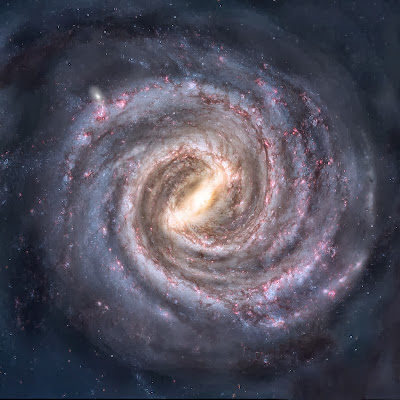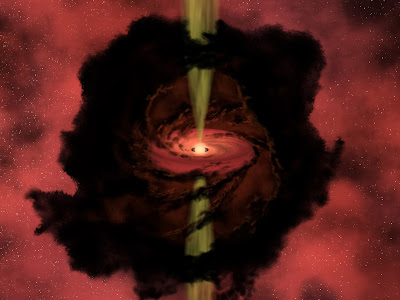 |
| Artist's conception of the Milky Way galaxy [Credit: Nick Risinger] |
According to Shirley, the survey is a major step forward in astronomy because it allows astronomers to study the earliest phases of star formation when the gas and dust in the star-forming clouds are just beginning to coalesce, before giving rise to clusters of stars. He explained that much of the research over the last 30 to 40 years has been very targeted towards regions where prospective stars, called proto-stars, have already begun to take shape.
"All the famous, major regions of star formation in our galaxy have been studied in great detail," Shirley said. "But we know very little about what happens in those star-less clumps before proto-stars form, and where."
The survey provides the first unbiased map of the galaxy that shows where all those regions are throughout the galaxy, in different galactic environments and at different evolutionary stages. This helps astronomers better understand how the properties of these regions change as star formation progresses.
According to the UA astronomer, the star formation rate in the Milky Way was higher in the past, and currently stars form on the order of about one solar mass per year.
How long does it take to become a full-blown star?
"That is something we hope to be able to calculate by comparing the number of sources that are in that early phase to the number of sources that are in a later phase," Shirley explained. "The ratio between the two tells you how long each phase lasts. In our survey there seem to be fewer regions that have not yet begun forming stars than those that have, which tells us the earlier phase must be shorter. If that phase lasted much longer, there should be many more of those."
Because the dense accumulations of dust are impervious to light in the visible spectrum, astronomers can't observe them with telescopes detecting light in the visible spectrum such as the Hubble Space Telescope.
"For those of us who want to study how stars form, that's a real problem because if we want to observe a young star or a cluster of stars forming in one of those dark clouds, all that dust gets in the way," said Shirley.
"Heat emanating from the young clusters of stars forming inside the clouds, combined with ambient radiation and even starlight from the surrounding galaxy, all that heats up those dust grains just a little bit above absolute zero," Shirley said. "As a result they glow, allowing us to peer inside the clouds with a radio telescope at very long wavelengths."
For their survey, which covers all parts of the galactic plane visible from the northern hemisphere, the group used the Sub-Millimeter Telescope at the Arizona Radio Observatory, equipped with a sensitive new receiver. Shirley said the proximity and accessibility of the UA-operated telescope made this project possible in the first place.
The survey, published in The Astrophysical Journal, resulted from a group effort including Wayne Schlingman, who completed his PhD at the UA last year and is now postdoctoral researcher at the University of Colorado Boulder; Brian Svoboda, a current doctoral student in the UA's Department of Astronomy, and Tim Ellsworth-Bowers, a current doctoral student at the University of Colorado Boulder and former UA graduate.
"Almost everybody on the team that put this all together has a connection to the UA," said Shirley, who himself graduated from the UA's department of astronomy before returning to join the faculty.



No comments:
Post a Comment